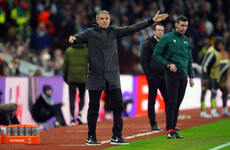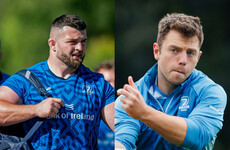TWO WEEKS AGO, Lidl released significant research surrounding teenage girls and their involvement in sport.
Among the mountains of statistics and information released were several key points.
Girls who play sport have significantly better body confidence and mental well-being. By the age of 13 though, one in two girls will have given up sport completely for a wide range of reasons from pressure to do well in school to lack of encouragement.
Before the research was released to the public though, it was presented to members of the media, among others, at a separate event.
There were whispers around the room when certain statistics were read aloud, and smiles galore after a video of schoolgirls speaking of how much sport means to them was shown on the screen.
One of those present on behalf of Lidl was their head of Corporate Social Responsibility Deirdre Ryan. More people will recognise the name for her own sporting endeavours though.
She’s an Irish high jump national record-holder, and donned the green singlet in London at the 2012 Olympics.
Afterward the presentation, she spoke about how some of the results of the research really disappointed her, considering her own sporting background and experiences.
“There are a few statistics that really struck a chord with me,” Ryan told The42.
“The biggest one was that 76% of girls give up because they’re not encouraged. For me, that was just really sad to hear because any time I felt like giving up it was my parents that really supported me to stay involved.
“The fact that 50% of girls give up in school and feel more academically under pressure. It’s important to give an understanding for parents and teachers and girls that being involved in sport will actually help you academically, and with your health and well-being.”
As a child, Ryan smiles, she was an all-rounder.
There was basketball, hockey, swimming, soccer, gymnastics, the list goes on.
“I did a bit if everything. I was one of those kids,” she says. “We were encouraged to try everything.”
But of course, there was her one true love of athletics.
Ryan joined Dundrum South Dublin (DSD) Athletics Club at the age of eight, with one goal in mind — to be like Sonia O’Sullivan. And of course, to be like Sonia, she had to be a distance runner.
“I was terrible at it,” she laughs. “I was absolutely gutted. I just wanted to be like Sonia O’Sullivan. I was devastated when I wasn’t great at it.”
Encouragement from her parents drove her on though.
“I just kind of kept going anyway. Mam and Dad just said ‘You’ll meet friends, it will be good for you, you can’t be great at everything so keep going.’
“I think dealing with not being good, and losing as well is really important and builds resilience in young people.
“I kept going and learned other things when I was involved in the sport, until I realised that I was actually quite good at high jumping, which was a nice surprise in the end!”
Ryan first discovered her invaluable talent when it came to high jump in her early teens. She was 13 or 14, and it was just at club training one night.
No massive eureka moment. No huge story. But one which lead to achievement after achievement; Europeans, Worlds, and the biggest stage possible being the Olympics.
“I just remember I was quite good at it. I am very tall, so people just think you’re either a high jumper or a basketball player.
“It takes a lot of coordination and explosive strength, which would be the opposite of distance running. I’d be more explosive, and it just kind of took of from there.”
For the next few years, she still did a bit of everything. Some long jump and some hurdling in terms of the track, while in school she still played basketball and hockey.
Those high jump achievements began to escalate and the scale got bigger and bigger, and by the time Ryan started college, she was forced to focus on high jump alone.
After representing Ireland at the 1999 World Youth Championships and savouring her first real taste of international competition, she made her first European senior indoor championships in 2002 — her first year in college.
Ryan went on to compete at a host of other European Championships, finishing 13th in 2006. And then there were the World Championships.
In Daegu in 2011, she cleared 1.95m which meant three things — she smashed her PB, she set a new Irish record and she qualified for the 2012 Olympic Games.
A lifelong ambition was about to be ticked off the list.
“I think I always wanted to go to the Olympics, even when I was a little kid,” she recalls.
“That’s what I wanted to do. First of all, for distance running. It was always on my radar. It was always my dream, I suppose.
“The dream became more realistic would have been that first year in college where I made my first European championship and started jumping those heights where I could see the qualification standard being within my reach.
“It was probably around that age that I said ‘I really need to find a way to prove, and do whatever I can to put those building blocks in place to be in a position to compete with the best of the best.”
How the Games themselves went for the Dubliner may not have been the exact dream she had always dreamed though.
2011 was her best year, as she says herself. There was that hugely successful Worlds, the broken record, the qualification. Training was going well, everything was falling into place.
But then disaster struck.
There was an ankle injury which plagued her for months before the Games, and then a complication with her back in the immediate build-up which hampered her performance.
She managed just 1.85m on the day, .08m off the qualifying mark. Obviously, it was absolutely gutting at the time, but in retrospect, it’s about much more than the few jumps themselves.
“It’s something I think you look back on now,” she smiles. “It’s more with the benefit of hindsight, and you think ‘God, it was really amazing.’
“When you’re there, you’re like ‘I want to get a medal, I want to get in the next one.’ But I was very injured. I was injured in London, I was injured the year after. My best year was probably 2011.
“It was an incredible experience, but I think looking back, you think through the years and it is more about what you learn along the way.”
And from there, she comes back to the aforementioned research. The importance of sport. And how it has such a positive impact on life in general.
“It does help your health and well-being, helps you deal with the stress of life, it helps develop your social skills and it’s more about what you learn along the way.
“Now, you realise. At the time, you’re so involved in it and you just want to do better, you want to jump higher and you want to win a medal but now, you look back and go ‘Wow!’
“No matter what level, if it’s school sports, or your local club or whatever, you learn discipline, you learn time management, social skills. I think that’s the really important message for parents.”
While she does her own thing in the gym and elsewhere, Ryan no longer competes.
She’s still heavily involved with the club, DSD holds a special place in her heart. She coaches the younger athletes coming through from time to time, and practices what the research preaches.
I help out when I can, not nearly enough as I’d like to but no, no more competitions.
“I wouldn’t like to see what I can jump now. Not very far. 1.50 or something,” she grins.
The42 is on Instagram! Tap the button below on your phone to follow us!















I tried a lot of sports too but I wasn’t good at any of them so I took to the high stool and it turned out I was a natural and took to it like a fish to water so keeping trying folks everyone has a gift!
@Colm: yeah,but the hangovers kid,the bloody hangovers,never worth it
Fantastic example of what can be achieved in sport,and how parents and guardians are so important,north for positive and negative , alongside our women athletes,boxers,rugby players, Gaa ladies etc, we’re boxing above our weight as a nation,but can only continue if funding is available,well done lady.